Here in the U.S., most grocery stores will not be carrying mangoes as green as what this mango chutney calls for, as the hope would be for the large pit to not yet have become hardened. I had to make do with mangoes that were green enough to be mostly hard, but nowhere near the greenness that would have made this chutney more authentic. Still, it was good enough. Can't complain.
And then the holidays hit.
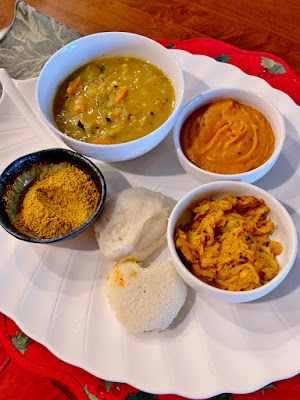 |
| Idli with Sambar and Chutnies |
It was with the Idli that I wanted to serve little bowls of different chutnies, and both these two chutnies were on the plate (shown in the photo above) - just not yet here on my blog.
The Tomato Chutney, or Tamatar ki Chatni, is pretty simple to make. It has a few ingredients not in everyone's household, so be warned. Particularly now, with access to a great Indian grocery, I have the ability to keep things in stock. Things such as Urad Dal, Chana Dal, curry leaves, asafetida or even tamarind concentrate. I have been using Swad's brand of tamarind concentrate with great success (it can be found on Amazon, here). Tomatoes and shallots, the bulk of the recipe, are available in most any U.S. grocery. The Indian chili powder can be substituted with cayenne, as per your preference.
 |
| Tamatar ki Chatni or Tomato Chutney |
Tamatar ki Chatni
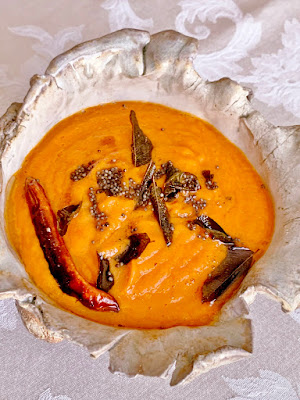 |
| Tamatar ki Chatni or Tomato Chutney |
Makes about 3 cups
1.5 lb tomatoes (600 grams)
12 oz shallots (342 grams)
2 - 3 cloves fresh garlic, chopped
1 tablespoon cooking oil
½ teaspoon chana dal (Desi chickpeas)
½ teaspoon urad dal
¼ teaspoon fenugreek seeds
¾ teaspoon salt
¾ teaspoon Kashmiri chili powder (or use cayenne to your heat preference)
½ teaspoon sugar
1 teaspoon tamarind concentrate
TEMPERING:
1 tablespoon cooking oil
½ teaspoon brown mustard seeds
1 dried red chili, whole
8 to 10 curry leaves
¼ teaspoon asafetida
Prepare the tomatoes: wash, then cut into chunks. Place them into a bowl and set aside. There should be about 3 cups of chopped tomatoes. Prepare the shallots and garlic: Chop the shallots and garlic and set aside separately from the tomatoes.
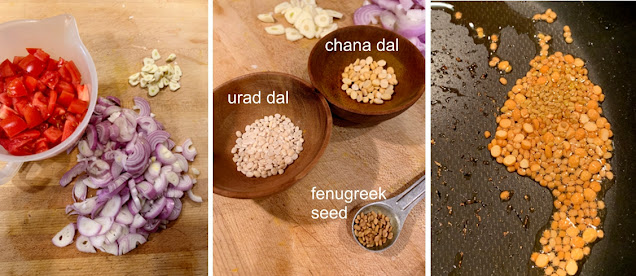 |
| Prep vegetables - measure the urad and chana dal and fenugreek - toast the dals and seeds |
Heat a large skillet and add in the first tablespoon of cooking oil. Once hot, add in the chana dal and urad dal and toast, stirring constantly, until deep golden in color, then add in the fenugreek seeds for a few seconds more. Add in all the shallots and garlic and saute until the shallots are tender, but not browned.
 |
| shallots raw then cooked - tomatoes raw then cooked |
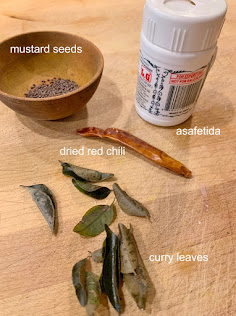 |
| Tempering Ingredients |
Add to the skillet the chopped tomatoes with the Kashmiri chili powder (or a pinch or two of cayenne), the sugar and tamarind concentrate. Lower heat slightly and cover, cooking until the tomatoes have completely broken down, about 12 minutes. Once cooked down, pour the contents of the skillet into a blender container and blend smooth. Pour into a bowl for serving.
Now prepare the "tempering" ingredients (tempering is nothing more than flavoring ingredients added in last, and whole): Heat a small skillet to very hot. Add in the tablespoon of cooking oil, then the mustard seeds. Cook until the seeds begin to pop, then add in the remaining ingredients all at once, stirring quickly, just until fragrant. Pour the tempering ingredients over top of the chutney to serve.
~~~~~~~~~~~~~~~~~~~~~~~~
On to the Mangoes
For the Mango recipe, firstly, the recipe is Tamil and this is technically called a "pickle." I have yet to truly understand what the difference is between a chutney and a pickle, in most cases. This South Indian recipe is termed "pickle" or Thokku.The fact that my mangoes were green and hard did not mean that it translated to green inside, so my "pickle" is still bright mango colored. It is strange to eat, as it is likely sweeter than it should be, were it truly made with green mangoes, but is not sweetened. I like the flavor. The recipe does have just a little heat. More can be added, to taste, or left out, as needed.
(or Green Mango Pickle)
Makes almost 2 cups
2 green, unripe mangoes
2 - 3 teaspoons Kashmiri chili powder, to taste
1 teaspoon salt
1 tablespoon neutral cooking oil
1 teaspoon brown mustard seeds
½ teaspoon fenugreek seeds
½ teaspoon brown sugar
TEMPERING:
1 tablespoon neutral cooking oil
6 curry leaves, lightly chopped
½ teaspoon brown mustard seeds
- pinch asafetida
Peel the mangoes and grate finely, then set aside.
Heat the tablespoon of oil in a skillet and cook the mustard and fenugreek until the seeds begin to splutter. Turn out into a mortar and crush the seeds. Set aside.
In the same skillet, adding more oil if needed, pour in the grated mango, chili powder and salt. Stir in the pounded seeds and the sugar. Stir well and cook for just a few minutes until the mixture loses some moisture and thickens. Turn out to a bowl for serving.
Tempering: In a separate skillet, heat the 2nd tablespoon of oil and add in the curry leaves, brown mustard seeds and asafetida. Cook, stirring, until the seeds begin to splutter, then pour over the mango mixture and serve.
My passion is teaching people how to create a harmony of flavors with their cooking, and passing along my love and joy of food, both simple or exotic, plain or fancy. I continue my journey in ethnic and domestic cuisines, continuing my journey to explore diverse culinary experiences and hopefully to start you on a journey of your own. Join me also at A Harmony of Flavors on Facebook, and Pinterest.
Green Mango Thokku
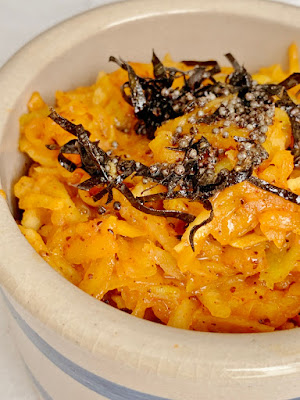 |
| Green Mango Thokku or Green Mango Pickle |
Makes almost 2 cups
2 green, unripe mangoes
2 - 3 teaspoons Kashmiri chili powder, to taste
1 teaspoon salt
1 tablespoon neutral cooking oil
1 teaspoon brown mustard seeds
½ teaspoon fenugreek seeds
½ teaspoon brown sugar
TEMPERING:
1 tablespoon neutral cooking oil
6 curry leaves, lightly chopped
½ teaspoon brown mustard seeds
- pinch asafetida
Peel the mangoes and grate finely, then set aside.
Heat the tablespoon of oil in a skillet and cook the mustard and fenugreek until the seeds begin to splutter. Turn out into a mortar and crush the seeds. Set aside.
In the same skillet, adding more oil if needed, pour in the grated mango, chili powder and salt. Stir in the pounded seeds and the sugar. Stir well and cook for just a few minutes until the mixture loses some moisture and thickens. Turn out to a bowl for serving.
Tempering: In a separate skillet, heat the 2nd tablespoon of oil and add in the curry leaves, brown mustard seeds and asafetida. Cook, stirring, until the seeds begin to splutter, then pour over the mango mixture and serve.
My passion is teaching people how to create a harmony of flavors with their cooking, and passing along my love and joy of food, both simple or exotic, plain or fancy. I continue my journey in ethnic and domestic cuisines, continuing my journey to explore diverse culinary experiences and hopefully to start you on a journey of your own. Join me also at A Harmony of Flavors on Facebook, and Pinterest.

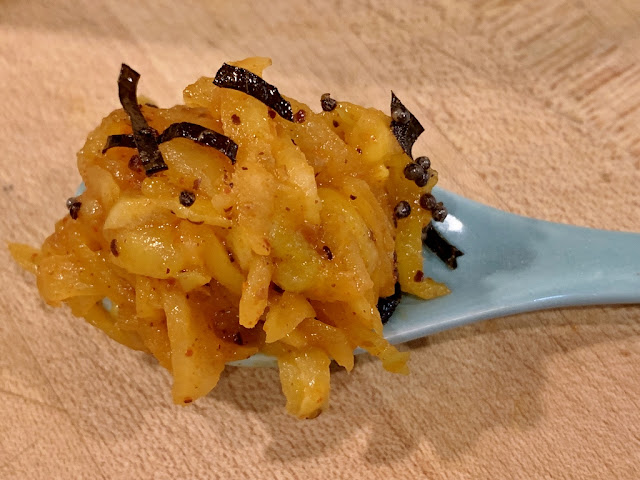
No comments:
Post a Comment